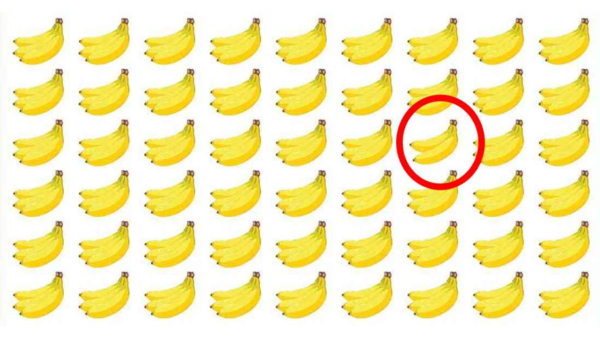This challenge will leave you scratching your head for hours altogether! The challenge is to find an odd banana bunch.
Solving this challenge will require you to put your focus and concentration in action together.
But, do not get disheartened. Here are 10 simple tips to solve optical illusions:
Start by examining the fine details of the illusion. Sometimes, the key to understanding the image lies in observing smaller elements closely.Look at textures, colors, and patterns to identify any subtle clues that can help reveal the true nature of the illusion.
Alter your viewing angle to see if the illusion changes. Optical illusions can sometimes appear different when viewed from various angles or distances. Move around the image, or shift your viewpoint slightly to gain a fresh perspective.
Try looking at the illusion using your peripheral vision instead of directly focusing on it. Peripheral vision can sometimes reveal hidden details that are not apparent when you look straight at the image.
If the illusion seems particularly challenging, take a break and return to it later. Sometimes, stepping away from the image can help your brain reset and process the information differently upon returning.
Try breaking down the illusion into simpler shapes or patterns. By mentally deconstructing the image, you might find it easier to understand how the different elements contribute to the overall effect.
Observe the colors and contrasts within the illusion. Colors and contrasts can create effects that trick the eye, so understanding how they interact might help you decipher the illusion more effectively.
Look for repeating patterns or symmetrical elements within the illusion. Recognizing these patterns can provide clues about how the illusion is constructed and help you interpret its true nature.

Solving this challenge will require you to put your focus and concentration in action together.
But, do not get disheartened. Here are 10 simple tips to solve optical illusions:
Start by examining the fine details of the illusion. Sometimes, the key to understanding the image lies in observing smaller elements closely.Look at textures, colors, and patterns to identify any subtle clues that can help reveal the true nature of the illusion.
Alter your viewing angle to see if the illusion changes. Optical illusions can sometimes appear different when viewed from various angles or distances. Move around the image, or shift your viewpoint slightly to gain a fresh perspective.
Try looking at the illusion using your peripheral vision instead of directly focusing on it. Peripheral vision can sometimes reveal hidden details that are not apparent when you look straight at the image.
If the illusion seems particularly challenging, take a break and return to it later. Sometimes, stepping away from the image can help your brain reset and process the information differently upon returning.
Try breaking down the illusion into simpler shapes or patterns. By mentally deconstructing the image, you might find it easier to understand how the different elements contribute to the overall effect.
Observe the colors and contrasts within the illusion. Colors and contrasts can create effects that trick the eye, so understanding how they interact might help you decipher the illusion more effectively.
Look for repeating patterns or symmetrical elements within the illusion. Recognizing these patterns can provide clues about how the illusion is constructed and help you interpret its true nature.
If you’re struggling with a specific illusion, compare it with other well-known illusions. Familiarity with common illusion techniques can offer insights into how the new illusion might be designed.
Discuss the illusion with friends or family. Sometimes, sharing perspectives and ideas can provide new insights or reveal aspects of the illusion that you might have missed on your own.
Be open to multiple interpretations of the illusion. Optical illusions often have more than one possible explanation, and keeping an open mind can help you explore different angles and solutions.
Were you able to find the answer?
Here it is:

Denial of responsibility! Swift Telecast is an automatic aggregator of the all world’s media. In each content, the hyperlink to the primary source is specified. All trademarks belong to their rightful owners, all materials to their authors. If you are the owner of the content and do not want us to publish your materials, please contact us by email – swifttelecast.com. The content will be deleted within 24 hours.

